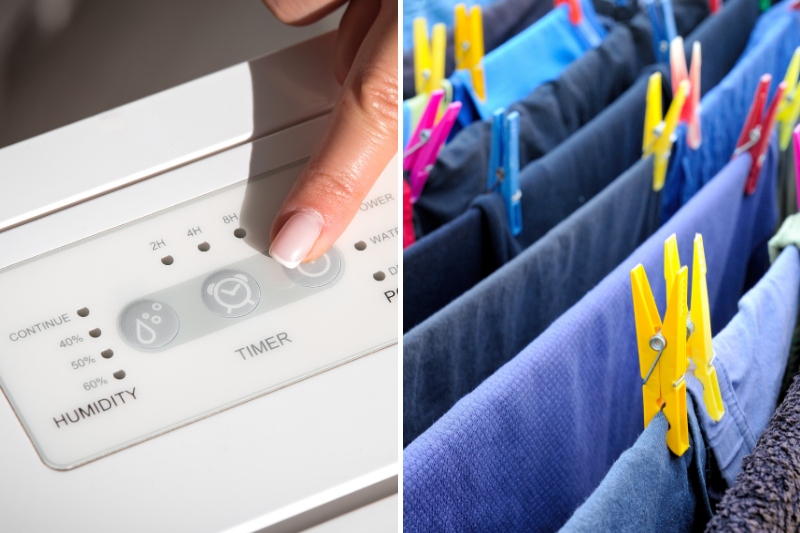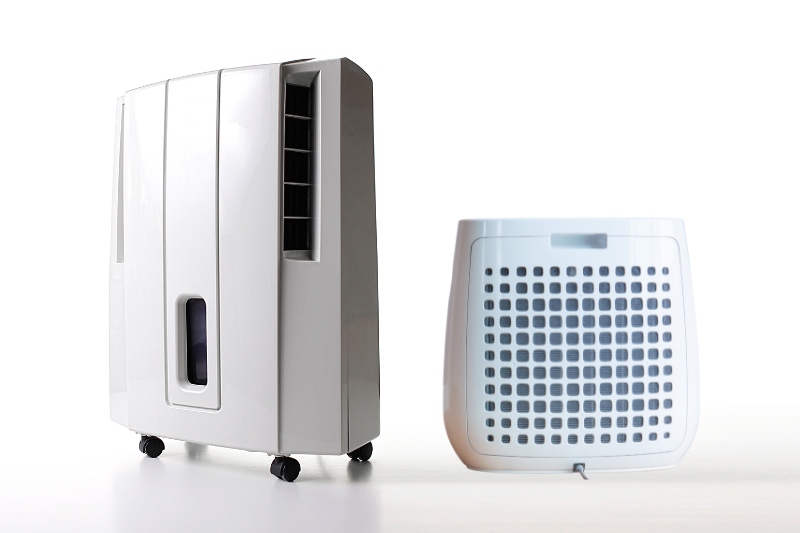Who’d have thought that a dehumidifier, the appliance used to remove unwanted moisture from the air (to stop potential problems like condensation and mould in a home), could be used to dry wet clothes?
Drying clothes using a dehumidifier is increasing in popularity, and for good reasons too! Dehumidifiers are cheaper to run than tumble dryers, portable, and can ensure the longevity of your clothes.
But just how long do these moisture-extracting machines take to dry laundry?
Sadly, there’s not an exact answer to this question because there are many variables you’ve got to consider. But here’s a rough guide for you to work on: it takes, on average, three to five hours to dry a load of laundry using a dehumidifier, and it would take your tumble dryer about an hour to dry the same load.
In some cases, you might be lucky, and you’ll be able to dry some small items (socks and pants) in two hours. But generally, you should expect a dehumidifier to dry your clothes over a longer period of time.
What Affects How Long a Dehumidifier Takes to Dry Clothes?

Factors that directly impact how long this drying process takes include the following.
1. Amount of laundry being dried at once
Naturally, the bigger the load, the longer it’ll take to dry, as there’s more moisture to remove.
2. Size of the drying room
The size of the drying room you decide to use will also impact the timeframe.
In a large room, the dehumidifier will have lots more air to collect, so the laundry will take longer to dry.
In contrast, if the room is too small, air won’t be able to flow freely, and this may hinder the drying process.

3. Dehumidifier’s power and size
A dehumidifier’s size and power will also significantly affect how long it takes to dry laundry.
Small units will likely take a while to dry a load of laundry because they might lack sufficient power.
Hence, they have to work for an extended period of time to extract all of the moisture from the clothes.
If you don’t have a laundry setting on your unit, it will be able to dry the clothes for you, but it’s likely to take a while to do so because there’s no dedicated setting.
So, it’ll just remove moisture from the air like normal, rather than targeting the laundry specifically.
Bigger units have more power, so the drying process can be sped up. And units with a dedicated laundry setting will also work quicker as they’ve been designed to dry wet clothes.
Keep in mind that larger and more powerful units may use more electricity, but it should still be less than that of a tumble dryer, for example.
Find the right dryer for you by checking out our guide on the best dehumidifiers for drying clothes.
4. Type of clothes you are drying
The type of clothes you’re trying to dry will also play a role. As mentioned above, small items like underwear will take less time to dry in comparison to large bulky items like thick jumpers.
5. How you use the dehumidifier
Not using the dehumidifier properly to dry laundry could also lead to longer drying times.
For example, if you don’t place the dehumidifier in the correct position, you don’t clean it out, or you don’t hang your laundry up correctly, you will find that the dehumidifier takes a long time to dry your clothes.
How to Speed Up Drying Clothes with a Dehumidifier

Dehumidifiers are a cost-effective alternative to using other, more expensive ways of drying clothes. But they’re not going to be the quickest of tools to use to dry laundry!
Here are some ‘good practices’ you can put into place right now to help speed up the process of drying clothes with a dehumidifier:
- Pick a small room and dry your laundry in there with a dehumidifier. By using a compact room, the dehumidifier can quickly and effectively collect the moisture in the room. In turn, it won’t have to waste time collecting moisture from large open spaces, so it can dedicate more of its time and power to drying your laundry. The type of room you could use includes a small bedroom, bathroom, or storage cupboard.
- Close the door and any windows, so the dehumidifier can get straight to work removing the moisture from the laundry. If you leave the door open, the dehumidifier will work hard to remove the moisture from the landing/other rooms and won’t be able to dry your clothes effectively or at speed.
- Hang or spread clothes over a clothes horse. And you should hang garments over multiple rails, so air can flow up and in between them. Clothes that are clumped together will take ages to dry.
- Place the dehumidifier as near to the laundry as possible and activate it.
- Choose the laundry setting on the dehumidifier if it has one.
- If you plan on drying laundry with your dehumidifier, make sure you choose one with a laundry setting, one with plenty of power, and a model that’s a good size. See our recommended dehumidifiers for more information.
- Remove excess moisture from laundry. Run your clothes through an extra spin cycle so they aren’t soaking wet.
- Put heavier items on the outside of the drying rack.
- Rotate garments every hour or so.
- Don’t choose rooms with soft furnishing in as the wet laundry could make things like cushions damp.
- Turn items inside out when you rotate them.
- Make sure the dehumidifier is clean and in good working order (not clogged up with dust or water-logged).
- Point the dehumidifier towards the heart of the laundry. Don’t point it at one side of the laundry because you won’t get even drying.
- Use a normal fan to help speed the process up and to circulate the air.
- If you have a heated airer, you could use that alongside the dehumidifier.
Is It Worth Buying a Dehumidifier to Dry Clothes?

Dehumidifiers can take several hours to dry laundry. So, if you need a speedy drying solution, then a dehumidifier isn’t going to be for you. In this case, it might be better to opt for a tumble dryer because it’s far quicker, for example.
However, dehumidifiers are cost-efficient to run, and as well as drying garments, they can prevent common issues from occurring in a home. These include removing excess moisture from a property, taking out condensation, and preventing mould and damp-related issues.
In addition to this, dehumidifiers ensure that clothes don’t lose their appearance (colours don’t fade), they continue to feel soft (clothes don’t shrink or feel rough to the touch) and have increased longevity because the items are not subjected to the harsh drying conditions that other drying methods put laundry through.
Plus, dehumidifiers are portable, some can push warm air out, so they can help to heat your home too, and they can remove impurities in the air and help to reduce allergies. It’s cleaner for those suffering from allergies.
There are, of course, costs involved with getting a dehumidifier and the better the model and power, the more the machine will cost.
But if you’re dedicated to using the machine to dry laundry, you should get your money’s worth out of it. And they’re usually a lot cheaper to buy in comparison to a tumble dryer, for example.
You also have to factor in that you need to maintain a dehumidifier (mainly cleaning and emptying it), but this shouldn’t take very long to do. And you must use the dehumidifier in the right environment, otherwise you won’t make the most of the appliance.

Bethan has a passion for exploring, reading, cooking and gardening! When she’s not creating culinary delights for her family, she’s concocting potions to keep her house clean!






